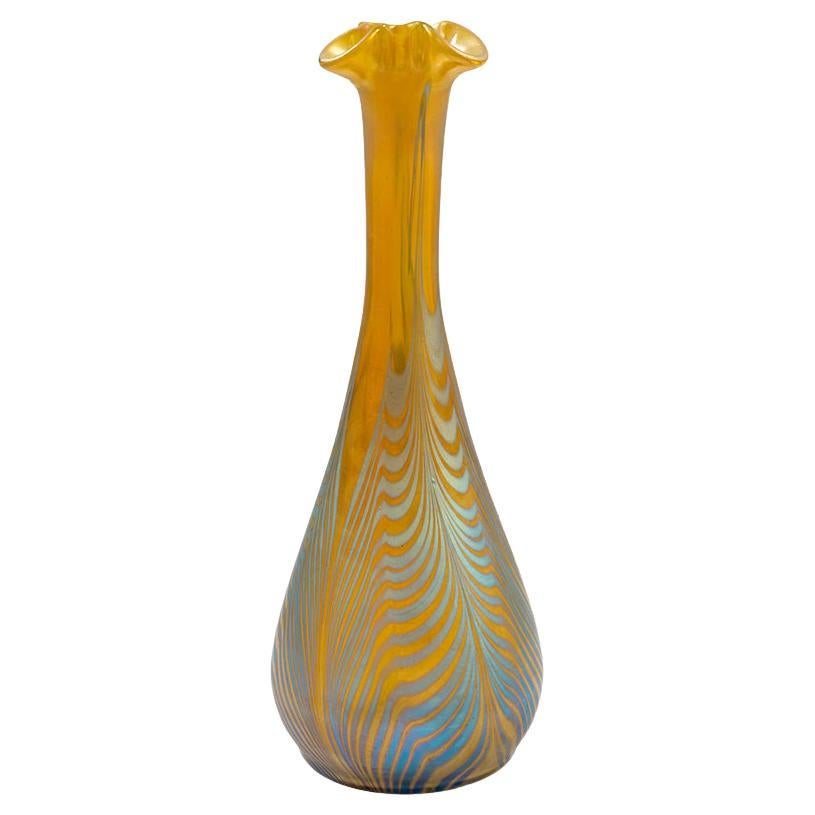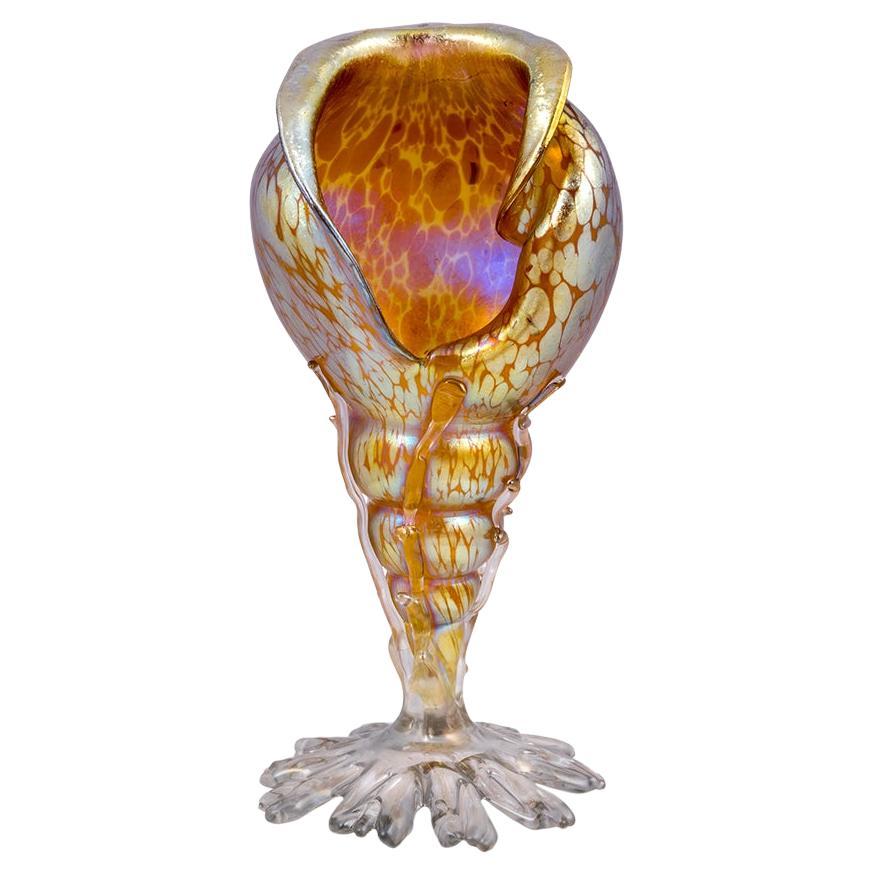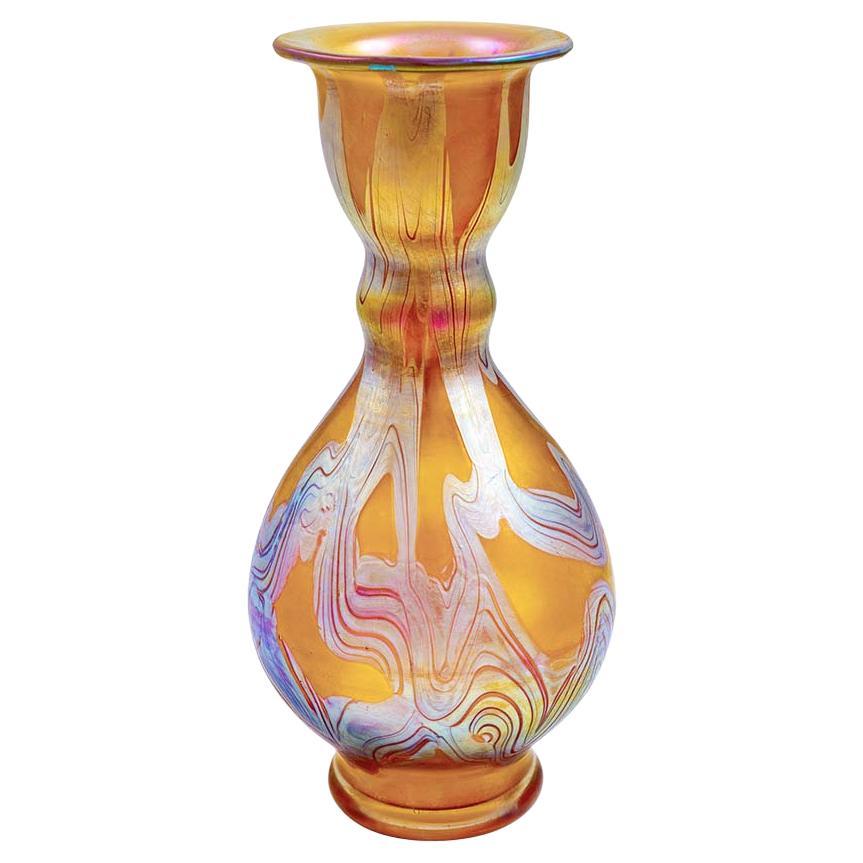Items Similar to Austrian Jugendstil Glass Vase Yellow Iridescent circa 1903 Loetz
Want more images or videos?
Request additional images or videos from the seller
1 of 6
Austrian Jugendstil Glass Vase Yellow Iridescent circa 1903 Loetz
About the Item
Austrian Jugendstil glass vase lemon yellow circa 1903 Johann Loetz Witwe decor Phenomen Genre 3/430
Our vase bears the decor called Phenomen Genre 3/430, which was designed in 1903. Its sober shape draws the attention to the elaborate surface design. Oval spots created with metal salts and warped threads rhythmically alternate and warp around the vase. These highly iridescent decorative elements stand out against the lemon yellow background, offering the viewer a colorful play of light.
Bib.: Passauer Glasmuseum (ed.), Bohemian Glass 1700-1950. Volume IV, Jugendstil in Bohemia, Tittling 1995, p. 53.
- Creator:Loetz Glass (Manufacturer)
- Dimensions:Height: 6.7 in (17 cm)Diameter: 4.34 in (11 cm)
- Style:Jugendstil (Of the Period)
- Materials and Techniques:
- Place of Origin:
- Period:1900-1909
- Date of Manufacture:circa 1903
- Condition:Wear consistent with age and use.
- Seller Location:Klosterneuburg, AT
- Reference Number:1stDibs: LU5830225123452
About the Seller
5.0
Vetted Seller
These experienced sellers undergo a comprehensive evaluation by our team of in-house experts.
Established in 2013
1stDibs seller since 2021
13 sales on 1stDibs
Typical response time: <1 hour
- ShippingRetrieving quote...Ships From: Klosterneuburg, Austria
- Return PolicyA return for this item may be initiated within 14 days of delivery.
More From This SellerView All
- Bohemian Glass Vase Loetz Austrian Jugendstil Yellow circa 1901By Loetz GlassLocated in Klosterneuburg, ATBohemian Glass Vase Loetz Austrian Jugendstil Yellow circa 1901 decoration PG 1/154 One of the main reasons for the big success of Loetz at the Pa...Category
Antique Early 1900s Austrian Jugendstil Vases
MaterialsArt Glass
- Conch Shell Glass Vase Iridescent Handmade Loetz Austria Jugendstil, circa, 1900By Loetz GlassLocated in Klosterneuburg, ATConch shell glass vase handmade by Johann Loetz Witwe Austria/Bohemia Jugendstil circa 1902 "Candia Papillon" Decoration. The extravagant Candia Papillon decor lends a special brilliance to the shell shape of this collectible. The iridescent quality of this decoration not only encompasses the outside of the intricately applied silver crumbled dots, but extends into the interior of the glass shell. A characteristic of this scroll vase...Category
Antique Early 1900s Austrian Jugendstil Vases
MaterialsArt Glass, Blown Glass
- Conch Shell Glass Vase Iridescent Handmade Loetz Austria Jugendstil, circa 1900By Loetz GlassLocated in Klosterneuburg, ATConch shell glass vase handmade by Johann Loetz Witwe Austria/Bohemia Jugendstil circa 1902 "Candia Papillon" Decoration. The extravagant Candia Papillon decor lends a special brilliance to the shell shape of this collectible. The iridescent quality of this decoration not only encompasses the outside of the intricately applied silver crumbled dots, but extends into the interior of the glass shell. A characteristic of this scroll vase...Category
Antique Early 1900s Austrian Jugendstil Vases
MaterialsArt Glass, Blown Glass
- Conch Shell Glass Vase Iridescent Handmade Loetz Austria Jugendstil circa 1902By Loetz GlassLocated in Klosterneuburg, ATConch Shell Glass Vase Handmade by Johann Loetz Witwe Austria/Bohemia Jugendstil circa 1902 "Diaspora" Decoration The naturalistically depicted shell and snail vases...Category
Antique Early 1900s Austrian Jugendstil Vases
MaterialsArt Glass, Blown Glass
- Bohemian Glass Vase Austrian Jugendstil Loetz circa 1899 Metallic YellowBy Loetz GlassLocated in Klosterneuburg, ATBohemian glass vase Austrian Jugendstil Loetz circa 1899 "Candia Papillon" decoration The shape of this vase was already documented in 1897, the Candia Papillon decor one year lat...Category
Antique 1890s Austrian Jugendstil Vases
MaterialsArt Glass
- Vase Iridescent Glass Johann Loetz Witwe Austrian Jugendstil Orange SilverBy Loetz GlassLocated in Klosterneuburg, ATVase iridescent glass Johann Loetz Witwe Austrian Jugendstil "PG 7773" decoration In the 1890s, the Loetz company tried to break with the convention of the regional glass production...Category
Antique 1890s Austrian Jugendstil Glass
MaterialsGlass
You May Also Like
- Austrian Loetz Iridescent Art Nouveau Glass Vase Sterling OverlayBy Loetz GlassLocated in Toledo, OHAustrian Loetz iridescent art glass vase in papillon finish with sterling silver applied overlay. Art Nouveau style in a dimpled form shades of green ...Category
Early 20th Century European Art Nouveau Vases
MaterialsGlass
- After Loetz, Bohemian Jugendstil Iridescent Art-Glass Flower Vase, ca. 1900By Loetz GlassLocated in New York, NYThis large elegant, museum quality flower vase was probably made by Johann LOETZ Witwe Glassworks (Klostermühle, Bohemia, circa 1900) is a superior example of Jugendstil ~ Art Nouveau luxury object. The semi-translucent art glass strikes a spectator not only with the uniqueness of its surface, reminiscent of crocodile skin, but also with unexpected color scheme - a combination of dark brown, old gold and green, covered with craquelure; against the background of iridescent violet. The vase is framed by outstandingly designed bronzed & patinated pewter mounting, consisting of simple large handles, almost geometric-form; with one wreath of leaves, crowning the neck; and the second, forming a base. The simplicity of the forms both, the glass vessel and the mounting are generating extremely interesting decorative effects, inherent exclusively to Jugendstil ~ Art Nouveau era. LOETZ Witwe Glassworks In 1836, Johann Eisner established a glassworks in the Southern Bohemian town of Klostermühle, today part of the Czech Republic. The Art Nouveau Period was the glory years of the company. The glassworks created large numbers of its own new designs of iridescent, trailing art nouveau glass, sometimes in collaboration with well-known artists and designers like Marie Kirschner and Franz Hofstötter (aka Franz Hofstätter). The company’s success during this period had two prime drivers – the technical expertise of Prochaska and the business acumen of von Spaun. Loetz Witwe created many of its own designs, and also supplied glass commissioned by major customers like E. Bakolowits (Vienna) and Max Emanuel...Category
Antique Early 1900s Czech Art Nouveau Vases
MaterialsArt Glass
- Loetz 1900 Austria Art Nouveau Miniature Cabinet Vase In Blue Iridescent GlassBy Loetz GlassLocated in Miami, FLMiniature glass vase designed by Loetz. Gorgeous and very beautiful antique miniature cabinet glass vase, created by Loetz. Made in Bohemia, Aust...Category
Antique Early 1900s Austrian Art Nouveau Vases
MaterialsArt Glass
- Loetz Austria 1900 Art Nouveau Miniature Cabinet Vase Blue Iridescent Art GlassBy Loetz GlassLocated in Miami, FLMiniature glass vase designed by Loetz. Gorgeous and very beautiful antique miniature cabinet glass vase, created by Loetz. Made in Bohemia, Aust...Category
Antique Early 1900s Austrian Art Nouveau Vases
MaterialsArt Glass
- Iridescent Glass Vase Attributed to LoetzBy Loetz GlassLocated in Buenos Aires, ArgentinaIridescent glass vase attributed to Loetz origin Austria, circa 1900 perfect condition oily motif.Category
Antique Early 1900s Austrian Art Deco Bottles
MaterialsArt Glass
- Iridescent Loetz Glass Vase with Flower Opening, 1940sBy Loetz GlassLocated in Milano, MIVase in Austrian iridescent Loetz glass, with a shape with a flower opening and colors from purple to beetle, made in the 1940s Measures: Ø cm 18 h cm 11 The production of Loetz glass began with Johan Loetz (1778-1848) in the 18th century through the takeover of the Klostermühle glassworks. In the second half of the 19th century, his nephew took charge of the modernization of the glassworks, introducing, thanks to the assistance of the inventor Eduard Prochaska, new processing techniques: thus new processes were born with glass in imitation of semi-precious stones, veins and the decoration. , which during processing includes hot coils or colored glass pads. Finally, at the end of the 19th century, the creation of the first glass iridescences with metallic reflections began, up to the creation of Phänomen in glass with applications and inserts of partially metallized glass filaments, similar to Tiffany glass and the famous Papillon glass...Category
Vintage 1940s Austrian Art Nouveau Vases
MaterialsGlass
Recently Viewed
View AllMore Ways To Browse
Antique Yellow Glass
Yellow Antique Glass
Yellow Glass Antique
Antique Yellow Bedroom Furniture
Yellow Glass Light
Lemon Yellow
Stand Light Glass
Lemon Glass
Antique Austrian Vase
Antique Austria Vase
Antique Austrian Vases
Austrian Vases Antique
Austria Vase Antique
Austrian Antique Vases
Iridescent Vase
Jugendstil Hall
Iridescent Metal
Iridescent Light





